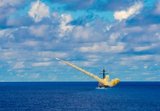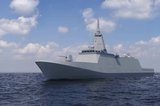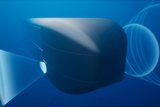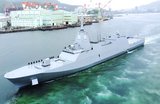New US Navy expeditionary ship commissioned
Expeditionary Sea Base USS John L. Canley (ESB 6) arrived at Naval Air Station North Island on 9 February, eight days before it was commissioned. (Photo: USN)
The fourth Lewis B Puller-class Expeditionary Sea Base (ESB) sealift replenishment vessel, the USS John L Canley (ESB 6), was commissioned on 17 February.
Built by General Dynamics NASSCO, six ships have so far been delivered across two variants: two Expeditionary Transfer Dock (ESD) and six ESB with the final two of the latter, Robert E Simanek (ESB 7) and Hector A Cafferata Jr (ESB 8), under construction.
The vessel has become the navy’s fourth ESB, with the others being USS Lewis B Puller (ESB-3), USS Hershel “Woody” Williams (ESB-4) and USS Miguel Keith (ESB-5).
The ships support a variety of maritime-based missions including Special Operations Forces and Airborne Mine Counter Measures. The ships have a four-spot flight deck, mission deck and hangar, and have been designed around four core capabilities: aviation facilities, berthing, equipment staging support, and command and control assets.
Shephard Defence Insight noted that the ESBs have a full load displacement of 90,000t, measure 239.3m in length, have a beam of 50m and a draft of 10.5m.
Powered by a commercial diesel-electric propulsion system, the vessels have a top speed of 15kt and a range of 9,500nm with 34 Military Sealift Command personnel.
The design features fuel and equipment storage, repair spaces, magazines, mission planning spaces and accommodation for up to 250 personnel. It can support MH-53 and MH-60 helicopters and MV-22 tilt rotors.
The ESBs have been equipped with a Mk-105 magnetic influence minesweeping sled, AN/AQS-24A mine hunting sonar system, AN/ASQ-232 airborne mine neutralisation system and the Mk-103 mechanical mine, Mk-104 acoustic mine and AN/SPU-1W magnetic minesweeping systems.
Related Programmes in Defence Insight
Expeditionary Sea Base (ESB) [USN]
Related Equipment in Defence Insight
More from Naval Warfare
-
![NATO tests use of “undetectable, jam-proof” laser communication in maritime scenarios]()
NATO tests use of “undetectable, jam-proof” laser communication in maritime scenarios
As part of its effort to better prepare its capabilities for operations in contested and congested scenarios, NATO evaluated a Lithuanian ship-to-ship terminal designed to not be susceptible to enemy interference.
-
![US Navy advances with the Harpoon Service Life Extension Programme]()
US Navy advances with the Harpoon Service Life Extension Programme
The US Navy plans to improve Harpoon’s anti-ship and land attack capabilities by equipping the missiles with sensors and technologies required for succeeding in future battlespace.
-
![Future of the Canadian Patrol Submarine Project is still unclear]()
Future of the Canadian Patrol Submarine Project is still unclear
The Canadian government remains tight-lipped on the timeline and funding required for the next steps of its Canadian Submarine Patrol Project, which should offer improved capabilities for the country’s navy.
-
![Mitsubishi eyes future with Australia’s Mogami selection]()
Mitsubishi eyes future with Australia’s Mogami selection
With Australia’s selection of the Mogami-class for Project Sea 3000, Mitsubishi is investigating local production in the next decade as potential export opportunities emerge.
-
![Thales’ new Sonar 76Nano could equip UK Royal Navy on anti-submarine warfare missions]()
Thales’ new Sonar 76Nano could equip UK Royal Navy on anti-submarine warfare missions
The new sonar is designed to equip uncrewed underwater vessels, with the potential to be used by the Royal Navy for its Atlantic Bastion and Atlantic Net missions.
-
![Hanwha wins Australian government approval to increase its stake in Austal]()
Hanwha wins Australian government approval to increase its stake in Austal
The contract would mean the two shipbuilders can collaborate strategically and enhance shipbuilding capabilities in Western Australia.























